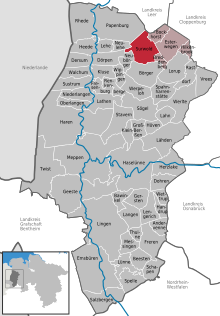King Surbold's tomb
King Surbolds grave (also called Surwold) was a Neolithic passage grave without Sprockhoff no. , about which little more than a legend is known. It is a megalithic grave that was razed at the beginning of the 19th century . It was one of the largest in the Emsland and was built between 3500 and 2800 BC. BC as a megalithic system of the funnel beaker culture (TBK). Neolithic monuments are an expression of the culture and ideology of Neolithic societies. Their origin and function are considered to be the hallmarks of social development.
Surbold's grave is near Surwold (Börgerwald district) in the Emsland district , in the Hümmling (a ridge), in the Emsland.
King Surbold
The Friesian king Surbold (Suirboldus) is said to have been an ally of the Saxon Duke Widukind and, like him, an opponent of Charlemagne and, according to legend, is buried here. Historians do not know of a Frisian prince of this name, but he appears in many legends. The Emsland community of Surwold, founded in 1879 a few kilometers north of Börger, was only given the name of the legendary figure in 1934.
The reconstruction of the facility
In 1935, the archaeologist Elisabeth Schlicht (1914–1989) found a 29 m long and 16 m wide flat hill at the excavation site. Their excavation report and their finds ( pearls , stone tools and pottery) were lost. Thus, only the description of the Münster sexton Johann von Velen , who examined part of the complex in 1613, has survived. The east-west-facing, strongly trapezoidal structure is said to have had seven, in some cases unusually large, cap stones (5.0 to 6.9 m long), three of which were still on the western bearing stones. Since the eastern part had collapsed, only incomplete measurements are available. The height of the bearing stones was given as 2.8 m, that of the edging stones with 2.2 m. The clear width of the chamber was between about 1.6 and 6 m, its internal length should have been 17 m.
Similar but smaller systems are at least partially preserved in the Osnabrück district ( Sloopsteine von Haltern ), Belm municipality, and near Hilter in the Teutoburg Forest .
Literary processing
A variant of the legend, according to which the huge grave slab was lifted, but the grave underneath was empty, is the basis of the story "King Surbold's Grave" by Petra Hartmann . In it, the author makes Surbold the legendary original king of the land of Movenna .
literature
- Hermann Veltmann: The tomb of King Surbold. In: Osnabrücker Mitteilungen. 13 (1886), pp. 242-262.
- Ernst Sprockhoff : Atlas of the megalithic tombs of Germany. Part 3: Lower Saxony - Westphalia. Rudolf-Habelt Verlag, Bonn 1975, ISBN 3-7749-1326-9 , pp. 90-91.
- Friedrich Laux: King Surbold's grave near Börger in the Hümmling . In: Archaeological Commission for Lower Saxony eV, Lower Saxony State Office for Monument Preservation (ed.): News from Lower Saxony's prehistory . tape 58 , 1989, ISSN 0342-1406 , pp. 117-128 .
- Elisabeth Schlicht: Suirboldu's rest house . In: Yearbook of the Emsland Homeland Association . No. 10 , 1963.
Individual evidence
Web links
- The giant bed in the Börgerwalde . In: Will-Erich Peuckert (ed.): Lower Saxony sagas . tape IV , no. 2702 . Göttingen 1968, p. 341 ( short version of the saga [accessed on September 29, 2013]).
